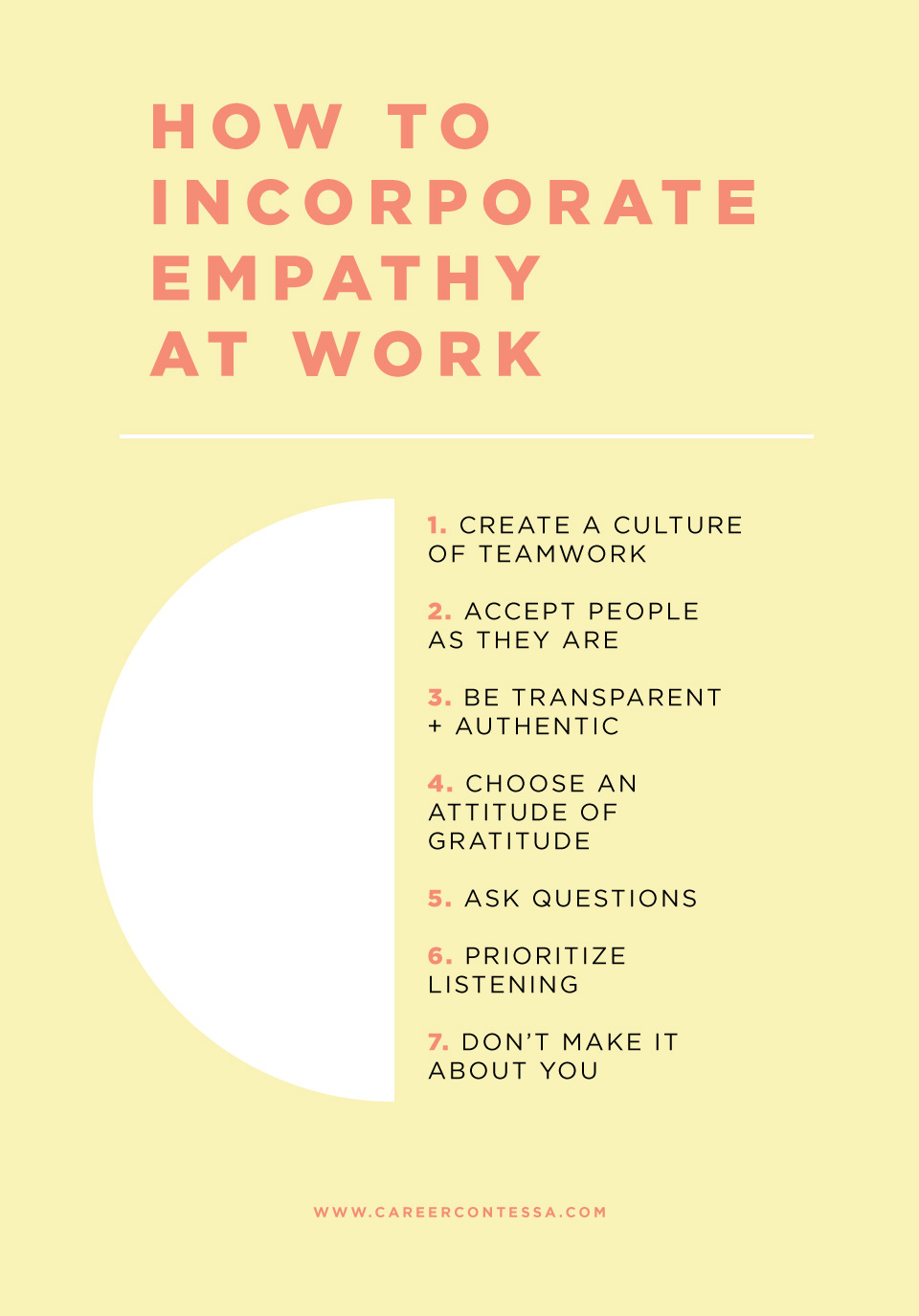Empathy at work is more important than ever.
If you've ever been told, "You're too sensitive," this read is for you.
I’m bothered by that sentence. If you’re an empathetic person, you’ve probably been told you’re too sensitive or emotional at some point in your life. Your sympathetic behavior might be criticized or cast off as unimportant.
Empathy is the ability to sense and understand (at some level) other people’s emotions. Sometimes, to me, it feels like my empathy is a real weakness. But empathy, in the workplace especially, is a strength.
- Only 1 in 4 employees believe that empathy in their organizations was “sufficient.”
- 93 percent of employees say that when their employer recognizes their professional accomplishments, it boosts their overall work productivity.
- 83 percent of Gen Z employees would choose an employer with a strong culture of empathy over an employer offering a slightly higher salary, versus 75 percent of employees on average.
- 83 percent would consider leaving their current organization for a similar role at a more empathetic organization.
It’s my empathy that allows me to intuitively sense a customer’s problem and immediately suggest solutions. It’s my empathy that recognizes the stress in a coworker’s response to a “to-do” timeline, that allows me to find a compromise in scheduling. It’s my empathy that allows me to work closely with other women to help tell their stories, to have a collaborative editing process rather than a frustrating one.
It’s not just
a gut feeling—studies have shown that empathetic employees, and companies that prioritize an empathetic culture, outperform ones that don’t.
Table of Contents
Types of Empathy
There are three types of empathy. The difference between them is in the action taken. So, while many of us might identify as very empathetic, we are too nervous to take action. In workplaces that don't prioritize empathy, it might even feel taboo to take time out of your busy day to create bonds, offer sympathy, or act as a source of support for our colleagues.
1. Cognitive Empathy
Cognitive empathy describes the emotional capacity to understand what another person might be thinking or feeling. However, cognitive empathy typically does not include any emotional engagement or support. In fact, some of your empathy-enabled folks can use cognitive empathy to manipulate vulnerable people.
Examples of Cognitive Empathy:
- A manager notices their employee is having a troubling week
- A salesperson recognizing that a client's loss of income is stressful
- A subordinate sensing their ornery boss fought with their partner
2. Emotional Empathy
Emotional empathy is the ability to sense and share the feelings of another person. A step beyond cognitive empathy, emotional empathy changes the person experiencing it. They might take it on, relate it to their own experience, or become overwhelmingly burdened by it.
However, when utilized in a healthy way, emotional empathy is a great way to bond with your human coworkers—or to realize that your boss is, in fact, a human.
Examples of Emotional Empathy:
- Feeling so overwhelmed by the news cycle that you find yourself crying at your desk
- Remembering your own parent's death when a coworker confides that their parent has just died
- Hearing your coworker being yelled at by your boss and remembering when it happened to you.
3. Compassionate Empathy
Compassionate empathy is the type of empathy we'll be exploring in this article. It's the most active form of empathy. This empathy involves feeling concerned and reaching out with actionable steps to remedy or reduce the impact.
Examples of Compassionate Empathy:
- A working mom comforting her coworker who just returned from maternity leave
- A leader providing space for BIPOC employees after upsetting racial tensions
- A project manager helping another project manager deal with a known toxic client
Why Empathy Matters at Work
Everyone wants to be productive—our
productivity “hacks” are some of the most popular articles and
resources we have. And I get it, I do. More work done in less time? Absolutely ideal. This is why I'm so excited to tell you all about our latest productivity hack—being empathetic.
Honestly, I wasn't surprised to learn that embracing empathy—either as an individual or as a company—actually boosts productivity, reduces turnover, and increases loyalty.
Not to mention,
diverse and inclusive offices can only truly work if there is empathetic leadership. (And we already know that
companies perform better when their talent is diverse.) If you hire talent without cultivating those employees' knowledge and experience, you’re not really doing anything. Empathy allows you to embrace our differences, and empathetic
leadership fosters those differences—different ideas, different perspectives, different strengths and weaknesses—to build better teams. To build better companies.
According to
HBR’s 2016 Empathy Index (I, too, was unaware that an "Empathy Index" existed, but here we are),
Entrepreneur explains, “The companies the index described as the most empathetic—Facebook, Google, LinkedIn, Netflix and Unilever—are indisputable leaders in their categories, signaling that empathetic individuals not only are more successful but empathetic teams, as a whole, are, too.”
Okay, so now that I’ve said it, scientists have said it, other people have said it—I hope you believe me when I say that empathy is an absolute must for any company’s set of values. (And yours, as an individual, too.) Now, let’s talk about how you can integrate empathy at your company.
How to Incorporate Empathy at Work
So, hello—there’s a massive gap in understanding between employer and employee. If you’re trying to prioritize empathy at work, there are simple steps you can take to boost your emotional intelligence and foster a better working environment.
Let’s run through some of my favorite ways to actually show empathy.
1. Create a Culture of Teamwork
This, to me, seems obvious. Empathy at work means understanding that not one person can do their job, without the help of other supporting roles at work. You can come up with a product, sure, but without a marketing team to sell it, or engineering and design teams to create it, you’re not going to get anywhere.
Companies are made up of people. And these people each need to do their jobs, and do their jobs well, so that other people can do their jobs. We all depend on each other. There is no time to be selfish or think that you’re self-made. We all learn and grow from our experiences, brainstorms, and meetings with our coworkers. Teamwork is the foundation of every great company. And empathetic teamwork—being able to step back and adopt or appreciate someone else’s perspective—well that’s game-changing.
2. Accept People as They Are
There’s a difference between having high expectations for your team members and making them feel like they aren’t good enough. Empathy means accepting other people as they are. We all have strengths and weaknesses—but dwelling on a person’s shortcomings isn't productive.
When your coworkers feel accepted and like they belong, it will help build a sense of trust on your team. If each person feels like they can be themselves at work—their true self—your team will be better off. When there’s trust in your team, feedback and creativity flow freely—essential qualities of a productive, efficient, high-quality performance team.
3. Be Transparent + Authentic
A big part of transparency is honesty—honesty about your successes, but also about your failures. Your shortcomings. Your mistakes. We all know that social media is snubbed for portraying a false sense of reality, a “highlight reel” of our lives. But in our actual lives, in our careers, we often default to that same “highlight reel” mentality.
Authenticity is empathetic—because when you’re authentic, you can help others see that they’re doing okay. A willingness to share your own vulnerabilities and lessons learned can make a huge difference to your overworked coworker navigating a frustrating mistake.
The idea that we "have it all," all the time—that’s nonsense. In being transparent in your failures and your successes, you’re lifting others up to know that they're allowed to make mistakes, too. They're allowed to mess up. They're allowed to feel lost or overwhelmed.
And, when they do make mistakes, they’ll be more likely to come to you for advice or help—because they know you’re understanding and empathetic to their missteps.
4. Choose an Attitude of Gratitude
If you know me, you know this is my number one priority in
life, but it’s also important at work. Gratitude reciprocates (
thank you, Matthew McConaughey)—meaning that when you’re conscious about being grateful, you find more and more to be grateful for. Grateful people are also happier, which probably means you’ll be an even greater pleasure to work with than you already are.
Gratitude for where you are now in your career doesn’t have to translate to “this is good enough, why would you need anything else?”
Instead, gratitude in your career should mean, “I am so grateful to be here, now. I am grateful to keep learning and growing and reach my next goal, too.” Your gratitude spreads empathy through your actions, and your perspective. Even saying “thank you” to the person who holds the door for you, or grabs the coffee mug for you, can have impacts you can’t see.
5. Ask Questions
Asking questions is key because it shows you’re interested in another person's perspective. I say ask questions because I don't want this to be taken as “ask for favors.” Whether it’s your coworker, your manager, or your employee, take time to ask how they’re doing, how they’re feeling about their workload, or what they think about an upcoming project or presentation.
Take the time to pay attention to, and care a little (at minimum), about your coworkers. You’re with these people every day. Why not have an understanding of who they are? There’s a second part to this tip...
6. Prioritize Listening
Asking questions isn't very effective if you’re not going to listen to the answers. And we could all be better listeners—all of us. Active listening is an insanely important skill, especially for leaders. Don’t ask questions to give yourself an opportunity to share your own perspective. Ask questions to listen and really hear the other person.
This means silencing that little voice in your head that says “Ugh, we get it, Karen, you’re tired. We’re all tired.” It means breaking the bad habit we get into where we finish the other person’s sentence before they do. Don’t assume that you know the answer to your question.
Take the time to listen to someone else's perspective. Cast aside your judgment or assumptions to hear the critical part of what someone is trying to communicate. Improving your listening skills will unlock one of the biggest benefits of empathy. It's learning from the experience of others.
I believe it's the key to innovation.
7. Don’t Make It About You
Are you talking about me?
Humans are inherently selfish in that we see the world based on our own experiences. It's both crucial to our survival and short-sighted at times.
When we make everything about ourselves, we're potentially opening ourselves up to tense situations—especially with coworkers. This goes back to the assumption thing.
Pay attention to nonverbal cues and facial expressions, but know they are likely not about you. Don’t assume that your coworker’s sigh or toe-tapping during your meeting had anything to do with what you were saying. Don’t assume that someone’s standoffish attitude or lack of laughter at your hilarious jokes (it happens to me all the time) is about you.
While it might actually be the case that you’re not that funny (not relevant to me), it could also just be the case that your coworker has a lot going on, or is having a rough day. Maybe they suffered a personal loss or they're struggling with a health issue. You simply don't know what you don't know.
Your empathy means that you recognize this and can act in a way that doesn’t add to their stress.
Prioritizing empathy at work changes how you work. And if you’re lucky, it can change how others work, too.
8. The Small Things Matter
It's easy to get lost in the busyness of work. Life moves fast, and even the most empathetic person can miss a tone of voice or a troublesome turn of phrase from a struggling coworker.
I'm going to get morbid, but just for a moment, so please stick with me. At funerals, you'll often hear folks say things like, "I wish I could tell them how important they were," or "I wish I had said 'I love you' more often". While you're not likely in a loving relationship with your coworkers, the point still stands.
Say the nice things. Say them every time they cross your mind. For empathetic leaders, this means giving praise for good job performance. For coworkers, it can be as simple as a comment of appreciation. When was the last time you told Sue from HR that her laugh brightens your day?
While it might feel like no big deal to you, small gestures like this can be the trick to reducing someone's anxiety and bringing a smile to their face. That's huge.
On that note, you're beautiful.











